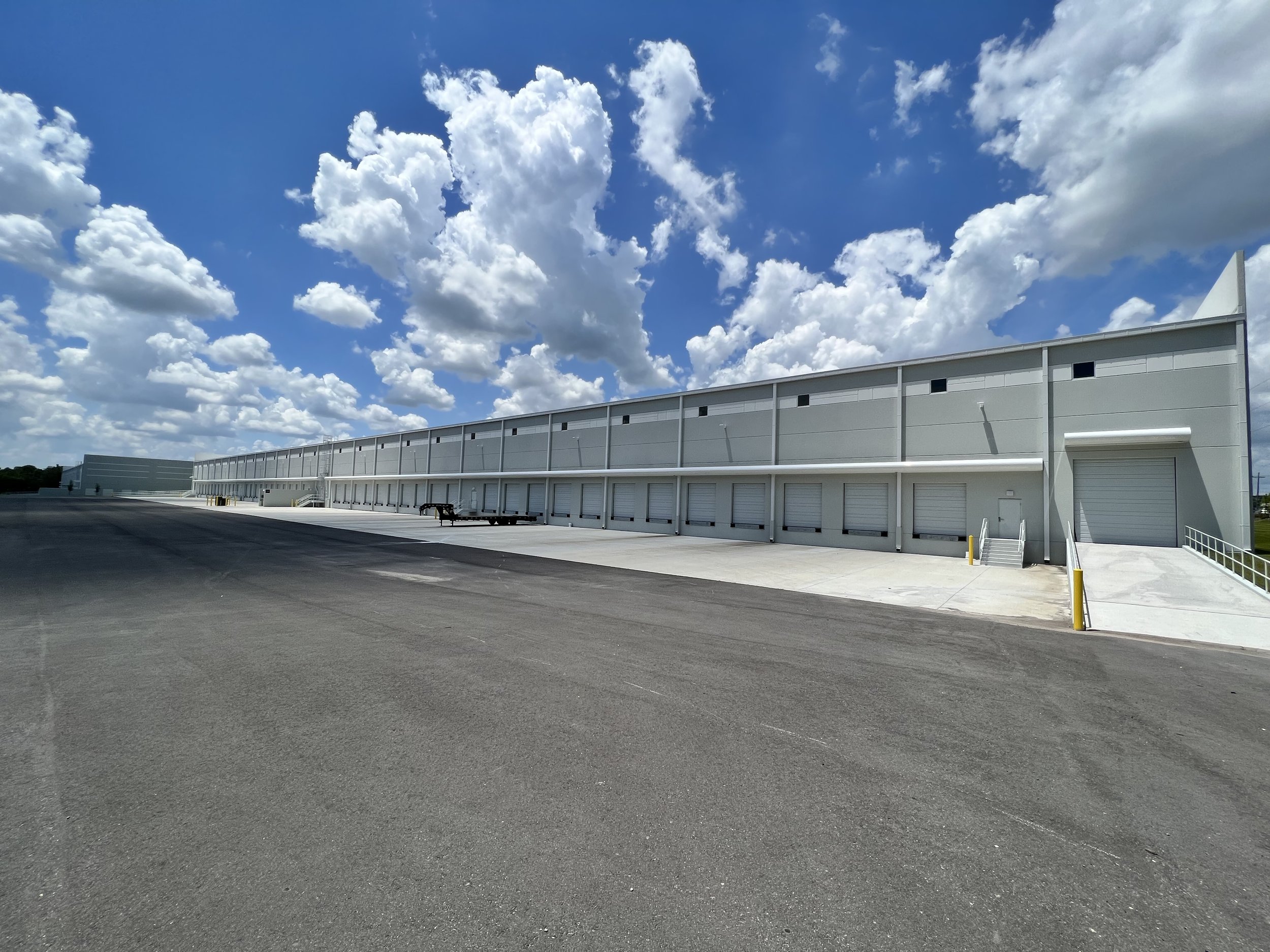Industrial real estate has been the strongest component of commercial real estate the past few years. Landlords have had the advantage, supply is still limited, and activity is still strong. What’s left available for lease or purchase is structural vacancy, meaning most of what’s left available is the leftovers that can’t be filled unless you’re really squeezing the foot into the shoe. It’s predominantly the Class-C product, and when any Class-A or B comes available it is gone in a matter of days/weeks, and this is causing rates to continue to increase 15-20%. Activity is so strong it’s causing holdover risk with some tenants as well.
Construction costs are unknown, and steel prices increased 10% each month in the early months of 2022, plus supply delays are 22-32 weeks in some cases, and that even leaks into office real estate in some construction material matters.
Demand locally on the west coast of FL has balanced the supply chain delays, and wage increases have balanced inflation. It is questionable to say that it is sustainable to stay at the growth pace we have seen the past year, and yeah… inflation is an issue but rates are still relatively and historically low, and the cost of capital is still favorable.
Market pace is feverish and although impressive, it’s unlikely to continue at this pace of growth and acceleration. Double digit percentage growth will slow to normalized levels.
One of the main things keeping this together is that revenue growth at tenant businesses is so strong, at a local level, that the rental increases have been buried somewhere unnoticeable. If demand slows, then we’ll see the cracks in the armor and possibly a slow down in pricing increases.
The supply chain has become an even more important component of consumer demand, now that we have moved even further into reliance on e-commerce buying and shipping habits. That has in turn fueled the growth in the industrial real estate markets, and the resulting development cycle.
Shortages due to demand are what’s keeping development top of mind and sustainable at this point in time. There is so much demand and so little supply that we are in a phase of catch-up. This is unique to industrial and multi family in our local area, due to the growth, and you’re not seeing the same trends in office or retail. Although, the office and retail markets are still strong and gaining momentum as covid restrictions get lighter and/or removed.
Now, knowing we have seen Fed rate increases, that has and will continue to affect cap rates and capital markets underwriting. Cap rates are going to move up along with uncertainty and increased costs, along with adjustments in development yields. The Fed rate decision will show us what’s next over the coming quarters as the increases work their way through the system and through everyone’s spending habits and thought processes.
How fast and steep the Fed raises rates will be the will be the signal to watch in order to determine what slows this down to a concerning pace. If it’s moderate rate hikes then it’ll balance out nicely. The wage growth environment we’re seeing is also helping buoy this economy differently than in prior inflationary periods.
Things causing concern are supply chain issues, labor shortages, persisting covid variants, the issue in Ukraine and it’s effects on oil, and which way the Fed is going to continue to go. Some of these are helping commercial real estate while others could be headwinds. Inflation is the focal point though. If real estate is a good hedge for inflation, considering there could be headwinds for demand, then the effects will be seen fairly soon.
Consumer Confidence fell in both January and February, but then it increased slightly in March to end the 1st quarter – with expectations about short-term growth prospects weakened, pointing to a likely moderation in growth during the first quarter of 2022. Nevertheless, the proportion of consumers planning to purchase homes, automobiles, and major appliances over the next six months all increased. Meanwhile, concerns about inflation declined for the second straight month, but remain elevated after hitting a 13-year high in November 2021. Concerns about the pandemic increased slightly in January, amid the ongoing Omicron surge, and concerns about inflation rose in February. Consumer confidence continues to be supported by strong employment growth and thus has been holding up remarkably well despite geopolitical uncertainties and expectations for inflation over the next 12 months reaching an all-time high. These headwinds are expected to persist in the short term and may potentially dampen confidence as well as cool spending further in the months ahead.”
Consumers’ grimmer outlook in June was driven by increasing concerns about inflation, in particular rising gas and food prices. “Purchasing intentions for cars, homes, and major appliances held relatively steady—but intentions have cooled since the start of the year and this trend is likely to continue as the Fed aggressively raises interest rates to tame inflation. Looking ahead over the next six months, consumer spending and economic growth are likely to continue facing strong headwinds from further inflation and rate hikes.”
Employment Trends Index stayed flat in January and the summary was that “It appears that the Omicron variant did not impact job growth as much as initially feared. Hiring and retention continues to be a challenge which we do not expect to dissipate anytime soon, especially for employers of manual labor and services. While an improving outlook for hiring and wages may attract some additional workers back to the labor market….” To end the first quarter, the Employment Trends Index rose again in March, signaling further solid job growth ahead in the second quarter of 2022, and the unemployment rate is expected to approach 3% by the end of the year, indicating severe labor shortages throughout 2022.
Even the May jobs report beat expectations and came in with employment increasing by 390,000. “While the Employment Trends Index rebounded in June, it remains below the index readings from March and April 2022, said Frank Steemers, Senior Economist at The Conference Board. “Moreover, a range of other economic indicators beyond the Employment Trends Index point to an economy that is slowing. Usually, it takes a few months for hiring decisions to adjust to changes in economic activity. Therefore, we expect positive, but decelerating, job growth over the next months.” With inflation still elevated and the Fed expected to continue to raise interest rates rapidly, the risk of a short and mild recession is growing.
Unemployment is still historically low, and forecasted to stay that way for quite some time, even through all the current volatility in the economy. The lockdown was the real reason we’re seeing most of the headwinds, and now that a surge of people are coming out of their homes it is exacerbating things, but its also keeping the economy going. Let’s call them growing pains…
Now that people have spent their stimulus checks, and savings have dipped, we should see people back at work and labor participation increasing. Hopefully that translates to productivity gains and easing of some of the pressures we’re seeing in inflation and supply chain.
The growth will occur in suburbs with work from home continuing and retail moving out there to serve the shifting population leaving urban areas. You can see that locally with the growth along US301 from Brandon down to Parrish. It is widespread!
Let’s just hope the consumer doesn’t take it too far and then ask the government for more stimulus. There isn’t anymore free money coming in this cycle. It’s going to be time soon where people will have to work hard to make this amount of stimulus back again after spending it and not saving much. Could also be a good thing to relieve some pressure from this period of poor productivity and supply chain issues. Maybe prices will come down again to a stabilizing point.
GDP growth in 2021 was 5.7% and that’s the highest in 37 years, and expectations this year are for 3+%. Although the first 2 quarters have seen negative growth between 1.4-2.1%
As I wrote this it was hard to stay on top of all the data coming out, but here are some more articles that were worth reading:

We are lucky to live on the West Coast of Florida where the trendline and the trajectory is upward growth. Even in cyclical recovery and recession modes, the trend line points upward for the foreseeable future. It is conceivable to see a decade of growth ahead of us, with sporadic corrections along the way.
Our runway is finally apparent and it has grown long.
I strongly believe that this will be a recession that is regional and one of perspectives. What do I mean by that? The recession will be different per region of the United States, and will also be different based on your perspective. Just because we’re coming from a peak it doesn’t mean we’re going to drop all the way to the bottom, and there’s a lot of room in between that could still be sustainable although not a record peak year.
This latest recession could show us that downturns are not uniform and can affect different states and regions differently. Especially important in this perspective is also whether or not this recession is a manufactured recession by the Fed, in order to tame inflation, and one that might not affect employment negatively.
If the U.S. is in a Recession, It’s a very strange one
“About two in five economists surveyed by the Journal in June said they saw at least a 50-50 chance that the U.S. enters recession in the coming year, but among them, few saw a big increase in the jobless rate. They forecast a 3.9% unemployment rate at the end of this year and a 4.6% unemployment rate at the end of 2023. The U.S. has never had a recession in the post-World War II era with a jobless rate that low.”
“If central banks do not tighten monetary policy to get inflation down now, the pain to the economy of moving to a high inflation regime” and getting stuck there is far greater, warned Subbaraman.
It will lead to wage price spirals, which would be “even more painful for the economy and for the man and woman on the street in the longer run,” he added.
“It’s hard to say this nicely… getting that pain up front and getting inflation down is better for the world economy and society than actually letting inflation get out of control as we learnt in the 1970s.”
Call Fortress CRE, so we can talk expert advice on where your real estate strategy should be focused in West Central Florida. Fortress Commercial Real Estate (CRE) adds value to business owners looking to grow through their real estate, office and building needs.
Visit www.Fortress-CRE.com and call or email me for more sound advice.


